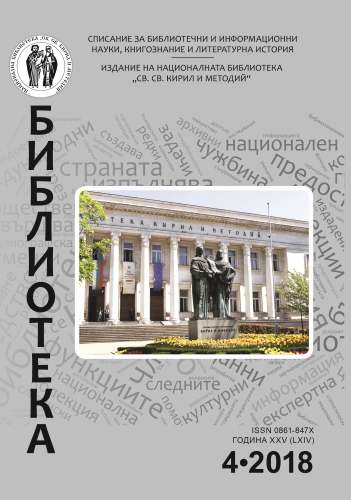Императив на теорията на библиографията в Западна Европа през ХVІІІ–XXI в. и разпространението по света на „немската линия“
Imperative of the theory of bibliography in Western Europe in ХVІІІ–XXI c. and the spread in the world of the german line
Historical and cultural phenomenological carcass of the information rhizome
Author(s): Alexandra KumanovaSubject(s): Library and Information Science, Other
Published by: Национална библиотека »Св. св. Кирил и Методий«
Keywords: kinds of bibliography; genres of bibliographic indexes; modes of bibliographic activity; types of bibliographic information; genesis of the bibliographic theory in Europe during XVIII–XXI c.;
Summary/Abstract: The actual bibliographic–humanitarian–cognitologic reticular task of the comparative secondary documental morphology consists in the possibility to create in straight and reverse chronological perspective a consecution of notions, used by bibliographers and librarians for fixing the particular bibliographic modes of the information modeling, existing in different cultural traditions, in various languages, in separate regions of the world: a humanitarian bibliography by approach (according the structures of the bibliographic information: 1. Documental; 2. Targeted; 3. Substantial; 4. Aspectual; 5. Functional; 6. Instructive; 7. Organizational).The observations carried out of the secondary documental rhizomatism of the planet, in which are enrooted the presented classification schemes connected with the genesis of the theory of bibliography in Western Europe during XVIII–XXI c. have a considerable importance not only for establishing the compliance of the history and theory of the bibliography, but also for decoding the cognitologic level of message of distinguished works… The comparative bibliographic studies show, that the profound contact of the Bulgarian renowned bibliographer Todor Borov with the “German line” (G. Schneider: classification of the bibliography /bibliographic indexes/, presented by indication “public function”) in the planetary development of the bibliography through the phenomenon of a bibliographic guide, elaborated on the ground of development and perception of Bulgarian (write in Cyrillic) conceptions for secondary documental field as correlated to the “German line”, examined in its own development during XVIII–XXI c. and as a ground, enrooted also with Anglo-American ideas in bibliography.The proper “German line” in the development of the bibliographic thought is completely in conformity with the terms, used in the Western European and Central and East European (Czech, Polish, Russian, Bulgarian, Romanian, etc.) bibliographic studies. The “German line” in the development of the classification bibliographic ideas contributes to the formation of the universal secondary documental knowledge and is more cultural than geographical phenomenon.
Journal: Библиотека
- Issue Year: 2018
- Issue No: 4
- Page Range: 34-54
- Page Count: 21
- Language: Bulgarian

